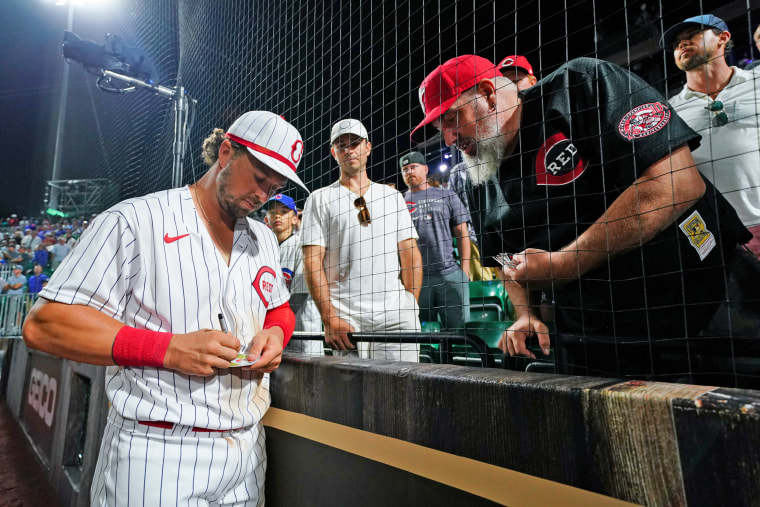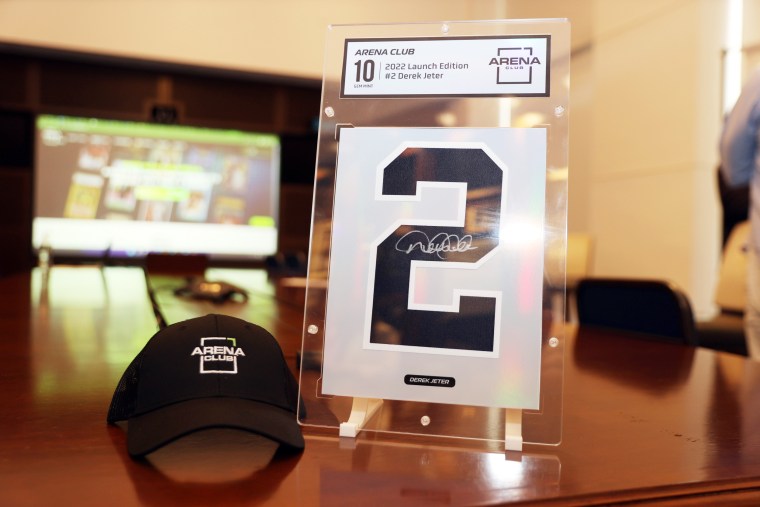Sports collectibles remain hot despite NFT boom
In the world of sports collecting, cardboard is still king – for now.
Despite the boom and subsequent semi-bust of digital sports collectibles over the past couple of years, the world of tangible sports collectibles — cards, jerseys, memorabilia and everything in between — has remained warm. The record for the highest paid for sports memorabilia has been broken three times this year, although prices for some popular cards have fallen from peaks in 2020 and 2021.
This market has been bolstered by a thriving online content industry around sports cards and memorabilia. Dozens of YouTube channels, podcasts and TikTok accounts track the market, and some offer a way for people to buy cards, jerseys and even autographed football helmets.
That has led to some optimism that NFTs, or non-fungible tokens (blockchain-based tokens tied to digital art), aren’t set to replace the thrill of opening a pack of cards anytime soon.
“I would say the future is 100% tangible,” said Mike Heffner, CEO of Lelands, a sports auction house that is approaching $50 million in annual revenue. “With an NFT, I don’t understand it; I just don’t see how it can bring the same excitement to anyone.”
Sports NFTs had their moment. Sales soared during the pandemic, with Deloitte Global projecting they would generate $2 billion in U.S. transactions this year, nearly double that of 2021. But amid a crypto winter, the future trajectory of the sports memorabilia, tangible, or NFT, market is in dispute.

Heffner said his company has tried a couple of NFT deals that didn’t work and now exclusively auctions of tangible items. He doesn’t plan to move into the NFT space anytime soon.
The resurgence of trading cards quickly built on itself at the start of the pandemic. With live sports halted, many restless sports fans nostalgically searched the attic to check the value of a former hobby. Stirred by viral TikTok and YouTube videos of collectors opening packs of valuable cards, some dusted off well-conditioned cards that sold for thousands of dollars, and a few for millions.
One of the largest sports memorabilia auction houses, Goldin Auctions, collected $100 million in 2020 sales and more than tripled that in 2021.
Meanwhile, the success of NBA Top Shot, arguably the most successful sports NFT market, soared and eventually crashed. The platform – powered by Dapper Labs, a blockchain startup that has raised hundreds of millions of dollars in funding – boasted around 180,000 unique buyers as of March 2021, according to data from NFT tracker CryptoSlam. In August 2022, the number dropped to less than 10,000 buyers. The prices of Top Shot NFTs followed a similar trajectory.
“Just like crypto, sports NFTs were driven by so much concern about money and value,” said Darren Rovell, a sports business reporter for the Action Network and avid sports ticket collector.
It was the first cultural and internet craze for sports NFTs, but the love of the commodity kept the tangible market thriving, and that’s where the focus is now, Rovell said.
“I’m just not convinced there was much joy involved [NFTs],” he said.

Some collectors saw tangible assets as a more stable financial investment than their digital counterparts.
“The tangible pieces continue to hold strong, hold value, even increase in value, while the NFT market has pulled back quite significantly,” said Chris Ivy, president and founder of the sports division of Heritage Auctions, which oversaw the record . Sale of a Mickey Mantle baseball card for $12.6 million in August.
There is a place for NFTs in the market, but it’s with a new type of collector, said Ivy, who has been with Heritage Auctions for 22 years. “Traditional collectors want the tangible object,” he said.
Millennials are driving the NFT market, according to a Morning Consult survey that found 42% of all NFT collectors are 26 to 40 years old.
Some are still keen to capitalize on the NFT sports market and see it as the future of sports memorabilia, in part due to the support of all-star athletes.
In September, baseball Hall of Famer Derek Jeter launched Arena Club, a sports card collection company that seeks to bridge the gap between physical and digital sports card spaces by allowing users to submit their cards to be represented in a personal digital showroom.

NFL quarterback Tom Brady, who last year co-founded Autograph – a sports NFT company that allows users to buy digital assets signed by athletes like LeBron James and Steph Curry, and even non-sports celebrities like Quentin Tarantino and Paris Hilton — launched a fan club experience last month that gives digital token owners access to exclusive watch parties and a chance to meet Brady himself.
“Sports and NFTs just make sense as a combination,” said Ethan McMahon, an economist at Chainalysis, a company that monitors blockchain data. “There’s just so much that can be done with digital technology … not just ownership, but membership, and that’s just something the tangible side doesn’t offer you.”
McMahon said the decline in transaction volume for sports NFTs was proportionally less than the entire NFT market experienced during the crypto winter. He estimated that the revenue of sports NFTs is currently around $50 million per month and has been consistent since November 2021.
Much of the problem is the maturity of the market, McMahon said. NFT collections will often launch with sky-high sales that later drop to more standard price levels.
“A gathering can have a hot start, but it’s difficult to have a sustained level of activity, but that’s not to say the activity isn’t happening elsewhere in sports,” he said.
Some sports market experts argue that regardless of an NFT bounce back, tangibles and NFTs in the sports memorabilia market do not compete with each other.
“I do not think so [NFTs] is going to eat into the physical memorabilia market,” said Pete Giorgio, head of Deloitte Consulting’s global and US sports practice, which tracks and forecasts the sports memorabilia market. “The person who buys an NFT is not necessarily the person who buys Michael Jordan’s worn jersey.”
Like many who try to predict what’s to come, Giorgio predicted that the future of sports memorabilia is likely to consist of both markets.
“I think it will still be a mix,” he said. “I think both the tangible and the digital will play a role in that.”


